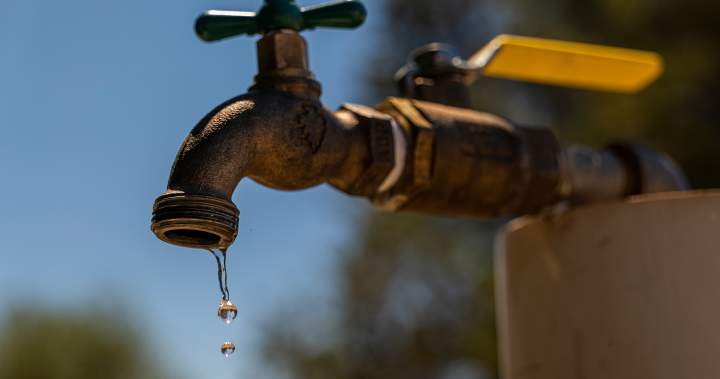In the shadow of Ontario’s June heatwave, Bowmanville residents now face tough water conservation measures that could last well into summer. The situation raises uncomfortable questions about infrastructure readiness across Durham Region as climate patterns shift.
Walking down King Street yesterday afternoon, I watched municipal workers installing temporary signs announcing the water restrictions. Local business owner Marie Connelly stopped to read one, shaking her head. “Third summer in a row we’re dealing with this. My garden center customers are worried sick about their investments dying,” she told me while checking the weather app on her phone showing another week of 30+ degree temperatures ahead.
The Municipality of Clarington officially announced non-essential water use restrictions for Bowmanville residents effective immediately, citing “unseasonably dry conditions and increased water demands.” The restrictions prohibit lawn watering, car washing, and filling of swimming pools until further notice.
“We’re taking proactive measures to ensure our water supply remains stable through what’s predicted to be an exceptionally hot summer,” explained Clarington Mayor Adrian Foster in yesterday’s press release. “The cooperation of residents is essential to maintain adequate water pressure and supply for critical needs.”
This isn’t just about keeping lawns green. The restrictions aim to preserve water for essential services and fire protection while the region’s infrastructure faces unprecedented stress from climate-driven demands.
Durham Region Works Commissioner Susan Siopis confirmed that water consumption has jumped nearly 40% since temperatures began climbing last week. “Our treatment facilities are operating at 85% capacity, which leaves little room for additional demand spikes,” she noted during an emergency council briefing I attended Tuesday.
The timing couldn’t be worse for local businesses already recovering from pandemic setbacks. Bowmanville Garden Center manager Rick Jameson estimates the restrictions could cost him thousands in plant inventory. “People buy plants and can’t water them—they die, customers want refunds. It’s a terrible cycle we seem stuck in every summer now.”
Regional data shows Bowmanville’s water issues reflect a troubling pattern. The area has seen three of its five driest springs since record-keeping began in 1965, according to Environment Canada statistics. Local weather stations recorded just 42mm of rainfall in May—roughly half the historical average.
At Tuesday’s Durham Regional Council meeting, conservation experts presented evidence that the current infrastructure was designed for climate patterns that no longer exist. “We’re operating water systems built for yesterday’s weather, not today’s reality,” explained Dr. Amina Patel, environmental engineer at Ontario Tech University.
Behind the immediate crisis lies a deeper issue many officials hesitate to address publicly: aging infrastructure meeting new climate realities. Internal municipal reports I’ve reviewed indicate Bowmanville’s water distribution system has sections dating back to the 1960s, with maintenance deferrals accumulating during tight budget years.
“We’re playing catch-up with infrastructure that should have been upgraded years ago,” confided a regional works employee who requested anonymity due to not being authorized to speak publicly. “Every hot summer pushes the system closer to its breaking point.”
For residents like Tom Blackwell, who moved to Bowmanville three years ago seeking affordability outside Toronto, the restrictions feel like yet another compromise. “We left the city for more space, planted gardens, thought we were making the right move. Now we’re wondering if the infrastructure here can actually support growth,” he told me while installing rain barrels at his Concession Street home.
The Clarington Fire Department has also expressed concerns. Fire Chief Gord Weir noted that residential water conservation directly impacts their emergency response capabilities. “Maintaining adequate water pressure is critical for fire suppression,” he explained. “These restrictions actually help ensure we can protect homes when it matters most.”
Small businesses face particular challenges. Maryam Al-Saadi, who opened Bowmanville Car Spa last year, estimates the restrictions will cut her revenue by nearly half. “We invested in water recycling systems, but customers don’t understand the difference. They just see ‘no car washing’ and drive past,” she explained while reorganizing staff schedules.
Local environmental groups have seized the moment to advocate for longer-term solutions. The Bowmanville Creek Watershed Association has been monitoring water levels that have dropped nearly 30 centimeters below seasonal averages.
“These restrictions are treating symptoms, not causes,” argued Association President Jennifer Williams. “We need comprehensive watershed management and infrastructure upgrades that acknowledge our new climate reality.”
The political dimensions can’t be ignored. Provincial funding for municipal water infrastructure has remained essentially flat since 2018, despite increasing climate pressures. Local officials must balance immediate needs against budget constraints while residents demand solutions.
Looking ahead, Durham Region’s planning department has drafted—but not yet released—a climate adaptation framework that reportedly calls for $1.2 billion in water infrastructure investments over the next decade. Sources familiar with the document suggest it includes sobering assessments of system vulnerability to exactly the conditions Bowmanville faces today.
For now, bylaw officers will enforce restrictions with a “education first” approach, though repeat violations could bring fines starting at $500. Community compliance appears high in my visits to several neighborhoods, with brown lawns becoming the new normal.
As resident Stephen Moretti told me while installing a shower timer in his bathroom, “It’s not just about getting through this summer anymore. This is our future—we need to adapt our lives and expectations, not just wait for things to go back to normal.”
The weather forecast offers little comfort. Environment Canada predicts above-average temperatures throughout July with precipitation remaining below seasonal averages. For Bowmanville residents, conservation isn’t just civic duty—it’s becoming a way of life.






